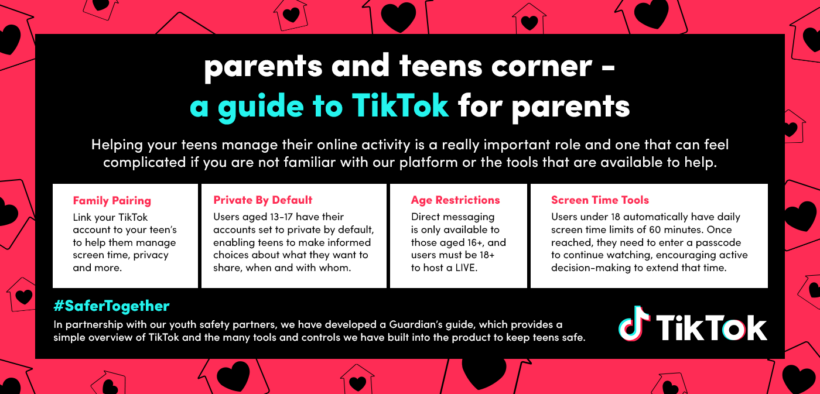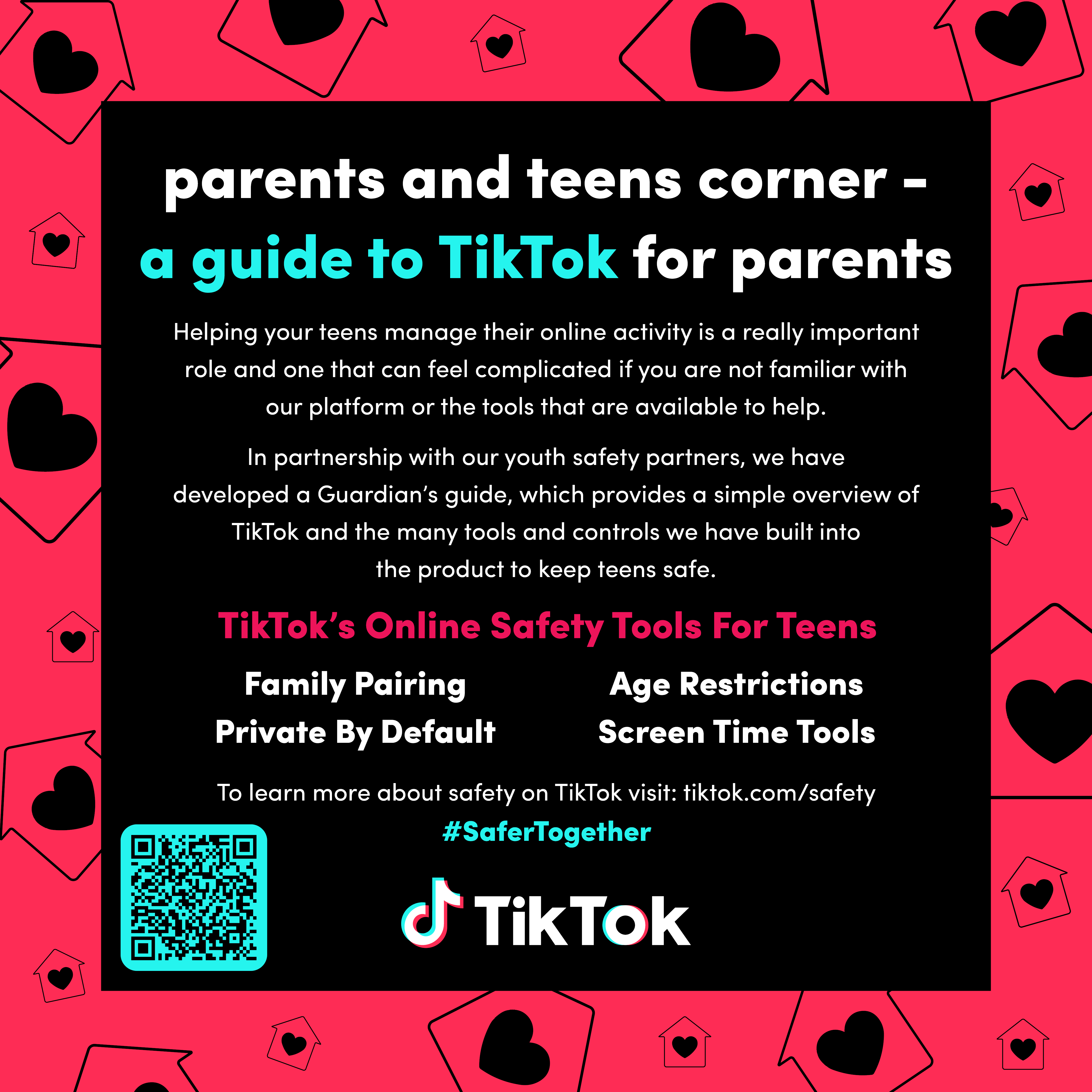How TikTok Is Empowering Parents to Keep Teens Safe Online: Insights from Mercy Kimaku, Safety and Integrity Lead, TikTok, Sub-Saharan Africa
In an age where digital connection is almost second nature to teens, TikTok continues to be a hub for creativity, self-expression, and community. But for many parents and guardians, the platform also raises concerns about online safety and screen time. How can families ensure their teens are enjoying the app while staying protected from potential risks? Mercy Kimaku, TikTok’s Safety and Integrity Lead for Sub-Saharan Africa, sheds light on the platform’s robust safety features—from Family Pairing tools to content filtering and screen-time limits—designed to create a secure, age-appropriate digital experience. Here’s what parents need to know to navigate TikTok confidently alongside their teens.

Mercy Kimaku | Supplied
1. TikTok has introduced several safety features aimed at protecting teens online. Can you outline the most important tools currently available for young users and their guardians?
• We truly believe that TikTok is a family experience and encourages parents and guardians to play a vital role in creating open lines of communication with their teens on digital safety. To help parents and guardians achieve this, we have developed a Guardian’s Guideas part of our safety centre. This guide provides resources and easy to understand explanations on how to use TikTok and how to use the safety features to keep your teen safe.
• To further support this effort, we are proud to have been the first platform to launch the Family Pairing tool.
o Through our Family Pairing Tool, parents can link their TikTok account to their teen’s to choose a variety of content, privacy, and well-being settings. This gives guardians the ability to monitor screen time, adjust privacy settings, and manage app safety features, ensuring a balanced digital experience for younger users
• TikTok is a 13+ app and people below this age should not have a TikTok account. It’s worth noting that TikTok has a has under 18 experience that aims to restrict the type of content user between the ages of 13-17 consume. Our Content Levels system is designed to prevent certain content with more mature or complex themes from reaching younger audiences. When we detect content that contains overtly mature or complex themes, for example, fictional scenes that may be too frightening or intense for younger audiences, a content level will be allocated to the video to help prevent those under 18 from viewing it across the TikTok experience.
• It’s important to note that TikTok is a 13+ app and we encourage parents and guardians to be cognizant of this when letting young people use their mobile phones or letting them download the app. We understand that, as parents or guardians, you may choose to create an account that features your children under 13 years old. To avoid an account being removed, it must show clear adult ownership of the account, including adult involvement in producing the content. If not, we’ll suspend the account and if the parent believes we have made a mistake, they may submit an appeal.
• We also have a 60 minute screen-time limit for accounts belonging to users under the age of 18. This proactive feature encourages responsible app usage and aims to foster healthier digital habits among teens.
• We’ve designed a neutral, industry-standard age-gate that requires people to fill in their complete birthdate when signing up for TikTok. If someone creates their account using another platform, they will also be asked to provide their birth date to us directly. If someone tries to create an account but does not meet our minimum age requirement, we suspend their ability to attempt to create another account using a different date of birth.
o If we suspect someone is below the minimum age to have an account on TikTok, we will ban that account. Last year, we removed around 20 million accounts suspected of being underage globally. Anyone can report accounts that they suspect are under the minimum age, either in-app or online.
• Platform safety remains a collective effort and we certainly encourage our community to report content that goes against our community guidelines.
• We also have reporting mechanisms available. Anyone can report accounts that they suspect are going against our community guidelines, either in-app or online.
• Additionally, young people can access our Youth Safety Center online which helps younger people understand the different features and safety tools available on TikTok. Whilst for parents, we have our Guardian’s Guide, which is available for parents and caregivers to learn more about the tools and controls TikTok uses to keep our community safe.
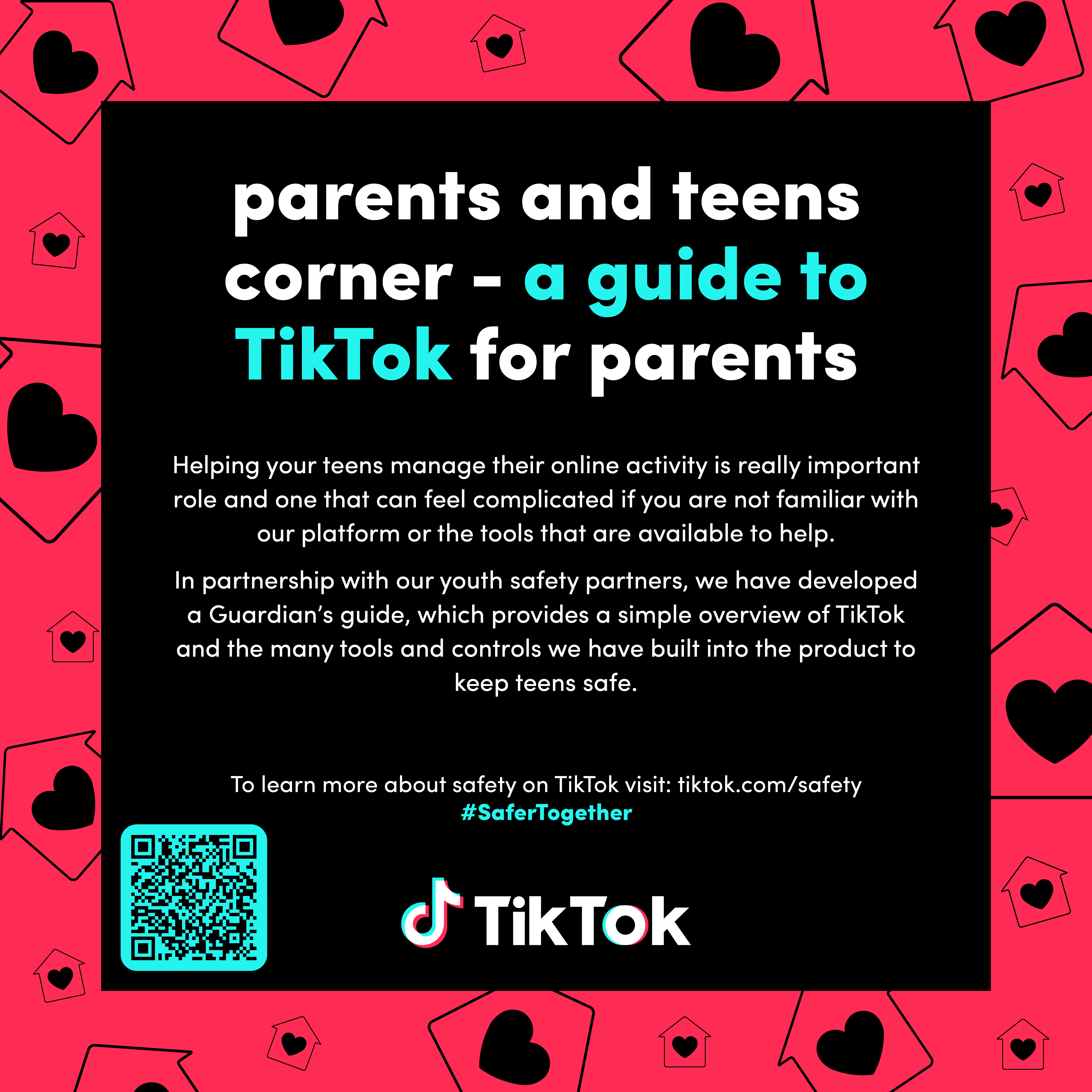
2. Parental control is a major concern for families. How does TikTok’s Family Pairing feature work, and what level of control does it offer parents?
• The Family Pairing Tool on TikTok allows parents, guardians, and teens to customise their safety settings based on individual needs. A parent or guardian can link their TikTok account to their teen’s account and set controls, including:
o Daily screen time: decide how long your teen can spend on TikTok each day. For teens between the ages of 13 and 17, this setting is turned on by default to one hour.
o Screen time dashboard: get a summary of your teen’s time spent on TikTok, including:
o The cumulative time spent each day for the last 4 weeks.
o The number of times your teen opened the app each day for the last 4 weeks. Learn more about screen time on TikTok.
o Mute push notifications: decide when to mute your teen’s push notifications. This setting is turned on by default.
o You can also schedule additional time to mute your teen’s notifications directly from your own account. Keep in mind that the default scheduled time overrides any custom time that overlaps with the default time. Learn more about how to mute push notifications on TikTok.
o Filter keywords: select keywords and their variations or hashtags to exclude from your teen’s supported feeds on TikTok and manage the visibility of your keyword list.
o Restricted Mode: restrict your teen’s exposure to content that may not be appropriate or comfortable for them.
o Linked account activity: get notifications about your teen’s activity, such as if your accounts get unlinked, by turning on customized updates and more push notifications.
o Search: decide whether your teen can search for videos, hashtags, LIVE videos, and more on TikTok.
o Discoverability: decide whether your teen’s account is private or public. With a private account, your teen can approve who can follow them and view their content.
o Suggest account to others: decide whether your teen’s account can be recommended to others. Learn more about suggested accounts on TikTok.
o Direct messages: restrict who can send messages to your teen or turn off direct messaging completely. Note: Direct messaging on TikTok is only available to registered account holders who are 16 years and older. Learn more about direct messages on TikTok.
o Liked videos: decide who can view your teen’s liked videos.
o Comments: decide who can comment on your teen’s videos. Note: TikTok’s Family Pairing settings are only available on the TikTok app and not on mobile and web browsers. If your teen accesses TikTok from a browser as well as the TikTok app, you may want to use the safety settings available on the mobile and web browsers, in addition to the Family Pairing settings on the TikTok app.

How to set up Family Pairing
To link parent and teen accounts:
1. Tap Profile in the bottom right.
2. Tap the 3-line icon in the top right.
3. Tap Settings and privacy, then tap Family Pairing.
4. Tap Parent or Teen.
5. Follow the steps in the app to link accounts.
|
• To help more people check our parental supervisory tools, we show an in-app message to every new community member over age 35 when they join our app.
3. Online safety is an ongoing conversation. How does TikTok ensure that its safety policies and tools keep up with the evolving digital landscape and new risks?
• We understand fully that the world of tech is an ever-evolving one. This requires us to ensure that our policies are in line with industry changes.
• We regularly update our community guidelines, with the last update taking place in 2024. Part of the regular updates is making sure that we help creators easily understand the community guidelines and avoid violating them as much as possible.
• In 2023, for the first time, we made our Community Principles public. These help people understand our decisions about how we work to keep TikTok safe and build trust in our approach. These principles are based on our commitment to uphold human rights and aligned with international legal frameworks.
• Understanding that we do not create our policies and tools in a vacuum, we officially launched the industry-first Sub-Saharan Africa Safety Advisory Council made up of academics and experts in online safety whose role is to help us develop forward-looking policies that not only address the challenges we’re facing today but also anticipate and tackle emerging issues in Sub-Saharan Africa.
• We also believe that young people also have a voice in shaping how we create a safe experience on our platform. This is why, in 2023, we launched our first Global Youth Council. The Council is comprised of 15 teens aged between 15 and 18 representing a range of communities and countries including the US, UK, Brazil, Indonesia, Ireland, Kenya, Mexico, and Morocco. The group first met in December 2023 and recently completed their second meeting, which was attended by TikTok CEO, Shou Chew. A new council will be established for the new year.
• Safety is the bedrock of our diverse, creative community, which is why our work in this space is never done. We are always reviewing our existing features and policies, and innovating to take bold new measures to prioritise safety. In 2025, we will be investing $2bn towards safety globally.
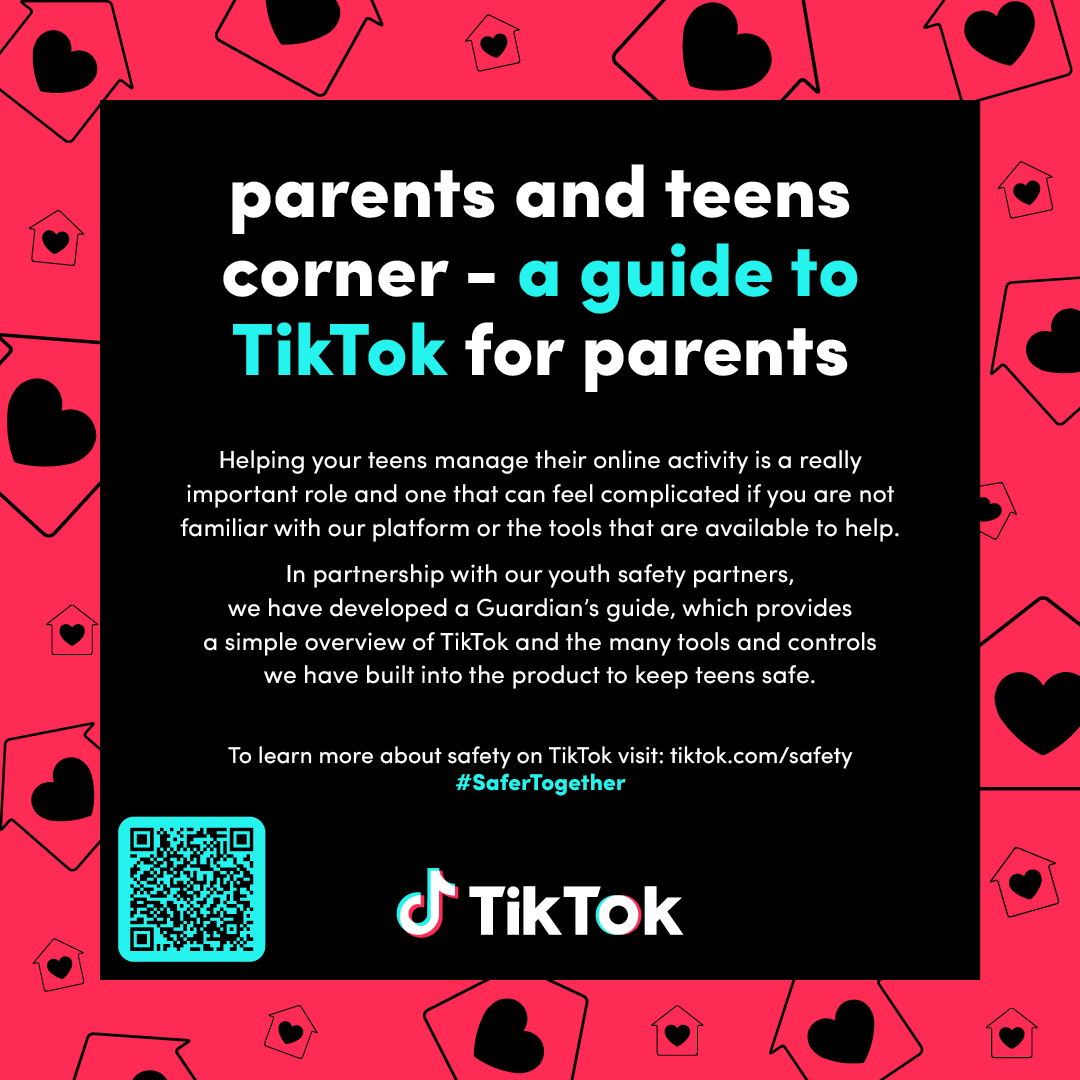
4.
Screen time management is a big issue for parents. What built-in features does TikTok provide to help teens develop healthier online habits?• Daily screen time is a screen time management setting that allows you to manage your usage on TikTok. It lets you set a daily screen time limit so that you get notified when you reach that time on TikTok. You can turn this setting on and off at any time. You can also view your screen time summary in your activity centre. Note: If you’re between the ages of 13 and 17, the setting is turned on by default to 1 hour.
• We also have a screen time dashboard . You can get a summary of your teen’s time spent on TikTok, including:
o The cumulative time spent each day for the last 4 weeks.
o The number of times your teen opened the app each day for the last 4 weeks. Learn more about screen time on TikTok.
• Parents can achieve this by linking their TikTok accounts to their teen’s accounts too, using the Family Pairing feature we mentioned earlier.
o To set up screen time limits and restrict your teen’s TikTok usage on mobile and web browsers, visit:

5.
Cyberbullying is a growing concern for young users. What measures has TikTok put in place to detect and prevent bullying, and how can users report harmful behaviour?• Cyberbullying is a widespread societal challenge that affects many industries today. As a platform, we have zero tolerance to bullying and harassment. We do not allow content that may put young people at risk of psychological, physical, or developmental harm.
• We also partner with local NGOs like Child Line South Africa to connect people and young adults who report potentially harmful or distressing content directly with mental health support and resources. If you see content that violates TikTok’s Community Guidelines, you can report it in-app by following these steps.
• Every quarter we release our Community Guidelines Enforcement Reports that detail the amount and type of content we have proactively removed. In the Q3 2024 Community Guidelines Enforcement Report, TikTok removed as many as 928,334 videos in South Africa from the platform for guideline violations. Impressively, 83.6% of these videos were removed within 24 hours.
• Platform safety remains a collective effort and we certainly encourage our community to report content that goes against our community guidelines
• Yes we have reporting mechanisms available. Anyone can report accounts that they suspect are going against our community guidelines, either in-app or online.
• Additionally, young people can access our Youth Safety Centre online which helps younger people understand the different features and safety tools available on TikTok. Whilst for parents, we have our Guardian’s Guide, which is available for parents and caregivers to learn more about the tools and controls TikTok uses to keep our community safe.
6. Content moderation is crucial on social media. Can you walk us through TikTok’s approach to detecting and removing inappropriate or harmful content before it reaches young users?
• Our Community Guidelines are the rules and standards that apply to everything and everyone on our platform, they also prohibit harmful misinformation. When content goes against our rules, we remove it or make it ineligible for the For You feed as outlined in our policies (learn about our policies here). We take action on misinformation regardless of intent.
• It’s also important to note that we use a combination of technology and human moderators to ensure that we are consistently enforcing our rules to detect and remove harmful misinformation, covert influence operations, and other content and behaviour that violates our Community Guidelines.
• To help ensure our moderation decisions are grounded in facts, we work with independent fact-checking partners who assess whether information is true, false, or unverified. If you see misinformation that might break our rules, please report it.
• With over a billion people around the world, using the platform and millions of pieces of content posted every day, TikTok continues to invest in technologies which improve content understanding and assess potential risks, allowing the platform to remove harmful content before it reaches viewers. With a proactive detection rate now at 98.2% globally, TikTok is more efficient than ever at addressing harmful content before users encounter it. Globally, between July and September 2024, the platform removed over 147 million videosglobally and of these, 118 million were removed through automation.
o Automated technology now removes 80% of violative videos, up from 62% a year ago. At the same time, our proactive detection rate has continued to improve; this quarter saw our highest result so far at 98.2% of videos removed before a user report.
• Our trust and safety teams continue to work around the clock to ensure that content that violates any of our community guidelines does not make it to the platform.
o We currently release quarterly reports on the content we remove on the platform; community guidelines enforcement reports. This report can be accessed on our website here: https://www.tiktok.com/transparency/en-au/community-guidelines-enforcement-2024-1?tc_version=2024- This forms part of our efforts to remain transparent.
• Safety remains a priority for us at TikTok and this has been a focus for many regulators and policymakers on the continent too. A priority we are highly aligned with. Over the last few months, we have showcased our global but local approach to how we ensure that we keep users on our platform safe.
• Earlier this year, we updated our Community Guidelines which further clarify our rules along with new features that help creators learn our policies and check their account status.
o We use both automated and human evaluation to detect and take action against violations of our Community Guidelines. If we find violations and remove that content, the account owner will be notified.
• With over 40 000 Trust & Safety professionals dedicated to safety on the platform, we continue to demonstrate things like how we moderate content, local partnerships for safety education such as the announcement we made with the African Union Commission to expand our #SaferTogether initiative across the continent. #SaferTogether – is an Africa-wide initiative that encourages wider stakeholder involvement in keeping TikTok safe. Partnerships with government, civil society groups, the users play a pivotal role in us ensuring that content that goes against our standards and community guidelines does not gain popularity.
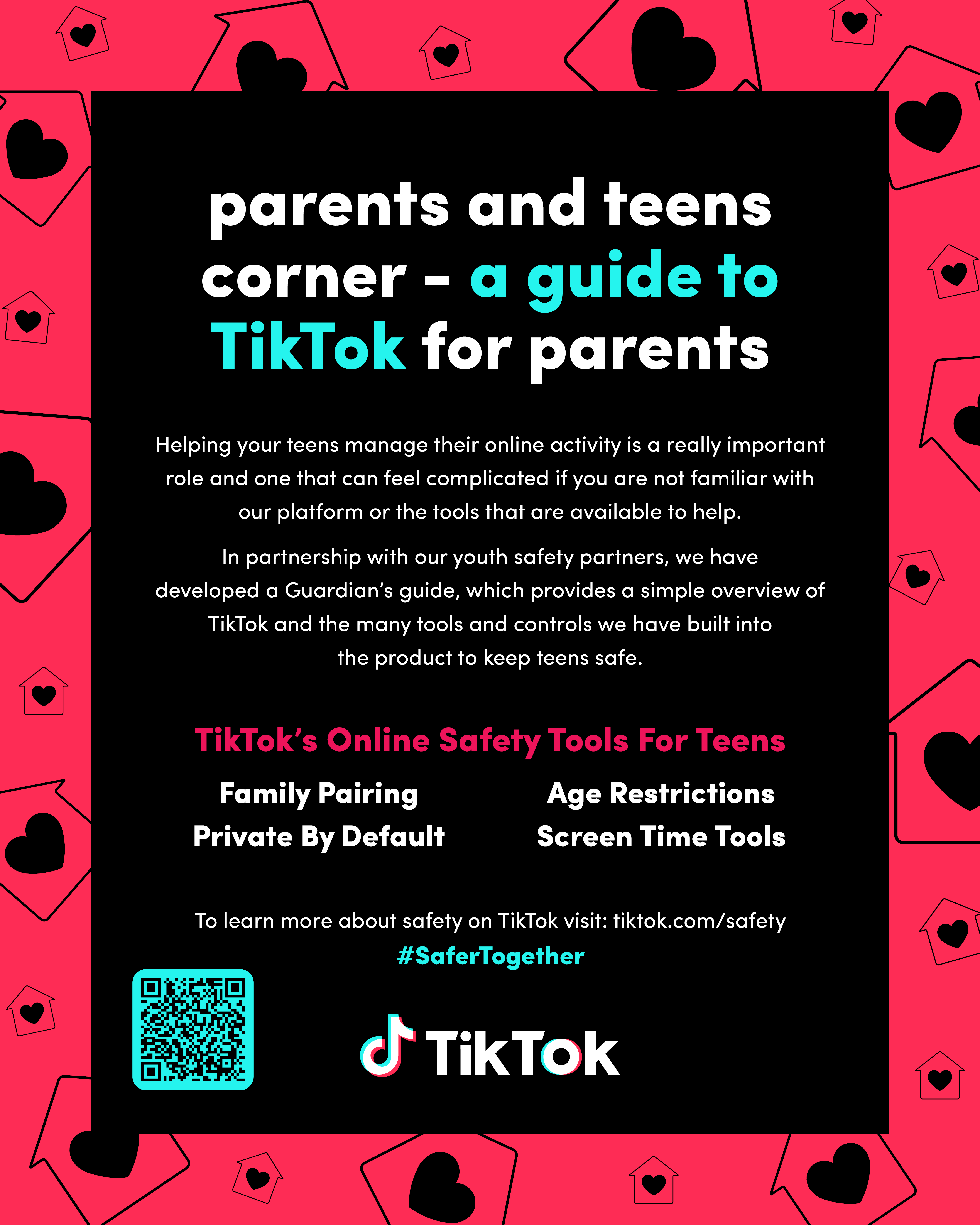 7. TikTok’s algorithm is powerful but sometimes controversial. How does the platform ensure that young users are not exposed to harmful or inappropriate content through the ‘For You’ feed?
7. TikTok’s algorithm is powerful but sometimes controversial. How does the platform ensure that young users are not exposed to harmful or inappropriate content through the ‘For You’ feed?• TikTok is the ultimate entertainment platform for creators, artists and publishers to thrive and showcase their creativity, offering unparalleled opportunities for growth and recognition.
• The For You feed is powered by a recommendation system that delivers content to each user that is likely to be of interest to that particular user. The system recommends content by ranking videos based on a combination of factors – starting from interests users express as a new user and adjusting for things you indicate you’re not interested in, too – to form your personalized For You feed.
• The For You feed is part of what enables connection and discovery on TikTok. It’s central to the TikTok experience and where most of our users spend their time.”
• As mentioned, TikTok is a 13+ app and people below this age should not have a TikTok account. It’s worth noting that TikTok has a has under 18 experience that aims to restrict the type of content user between the ages of 13-17 consume. Our Content Levels system is designed to prevent certain content with more mature or complex themes from reaching younger audiences. When we detect content that contains overtly mature or complex themes, for example, fictional scenes that may be too frightening or intense for younger audiences, a content level will be allocated to the video to help prevent those under 18 from viewing it across the TikTok experience.
• We understand that people express themselves in all sorts of way on TikTok – including when they’re feeling down or are going through a difficult life experience. We routinely hear from experts that closing the door on this expression can increase feelings of isolation and stigmatization, and that enabling people to see how others cope with difficult emotions can be beneficial, especially for teens. With this in mind, our approach is to remove content that promotes or glorifies self-injuryor our other policies, while allowing recovery or educational content, with limits on how often such recovery or educational content is eligible for recommendation.
8. There have been discussions about online challenges and their potential dangers. How does TikTok handle viral trends to ensure they remain safe for younger audiences?
• We welcome opportunities to participate in fun and creative trends. Most activities or challenges are suitable for everyone and bring people together, but some pose a risk of significant injury. We do not allow showing or promoting dangerous activities and challenges. Our Community Guidelines prohibit dangerous challenges
• The safety of our community is our priority and we work to proactively identify, review, and remove content that violates our policies.
• We created technology that alerts our safety teams to sudden increases in violative content linked to hashtags to help detect potentially harmful trends.
• We’re dedicated to the safety and privacy of our community. Together, we can keep inspiring creativity and bringing joy – all while staying safe and protected online.
9. For parents who may not be tech-savvy, what educational resources does TikTok offer to help them understand the platform and support their children’s digital safety?
• We want TikTok to be a family experience. We aim to provide a family-friendly experience, and we aim to ensure that parents, teachers, and guardians understand how our platform works. That’s why we’ll keep strengthening our partnerships for training through initiatives like #SaferTogether.
• We encourage parents to take interest in their teen’s online engagements. For TikTok, we have created a Guardian’s Guide, which is updated annually, with tools and resources that assist in opening lines of communication about online experiences.
• Yes, we have Community Guidelines that clearly stipulate what you can and cannot do on the platform for all. We, however, continue to make thoughtful industry leading product design choices to protect teens on our App. For instance:
o Direct messaging is not available to anyone under 16
o Accounts for people under 16 are automatically set to private along with their content. Their content cannot be downloaded and will not be recommended to people they do not know
o Every teen under 18 has a screentime limit automatically set to 60 minutes.
10. What advice would you give to parents and guardians looking to create an open dialogue with their teens about staying safe on TikTok and social media in general?
• We recognize that for a parent or guardian, it can feel overwhelming trying to keep up with new technology, and talking about online safety can seem daunting. We also hear from teens that they want their voices to be heard and respected. To help simplify things, we asked thousands of teens around the world to share how they’d like trusted adults in their lives to support them online. Here’s what they told us:
o Help me understand the rules: Teens don’t expect trusted adults to be experts on every app, but they value support to set up their accounts. This includes help with checking and understanding privacy and safety settings. They also told us parents shouldn’t be afraid to set boundaries; teens expect and even welcome them! Safety tools like TikTok’s Family Pairing features allow families to set parameters, which are especially important while teens are starting out online.
o Be available to chat: Teens want trusted adults to be interested in their digital life and to recognize how important it is to them. Teens feel supported when they know they have an ally that is available to talk to them. Don’t be afraid to initiate a conversation. They appreciate hearing you understand that things can go wrong online and you’ll be there to help if they do—no matter how big or small the problem.
o Don’t panic when things go wrong: your teen has come to you for help—fantastic! They may be feeling vulnerable, scared, embarrassed, or upset, so let them know how happy you are that they’ve reached out. When they share their problem, be mindful of your reaction; teens told us being met with anger means they will avoid asking for help again. Equally, teens don’t want adults to minimize their worries—even if it’s hard to understand why it’s causing so much angst. Listen with an open mind, ask questions, and focus on solutions. If they’ve broken rules, teens expect there to be consequences, but they also want help to understand what to do differently to avoid similar mistakes in the future.
o Trust me: teens get that trust has to be earned, and they expect adult oversight—especially for younger teens. Just as in the “real” world, teens feel greater autonomy online is appropriate as they get older. Every teen is different and the pace at which a teen moves toward independent use of technology will vary, but if your teen knows how to navigate platforms safely and they come to you when things go wrong, that’s a great foundation for trust.
o Respect my privacy : striking a balance between a teenager’s expectation of privacy and ensuring they are safe is one of the trickiest aspects of parenting—on and offline. It can be tough when a teen tells you they’d rather you didn’t follow them online. It’s natural to worry they’re up to mischief, when really it’s likely they just want some space to hang out with friends without being monitored. There may be good reasons why you feel following your teen’s account is necessary. If so, teens say they want to understand your reasons and to explore ways to build trust. Older teens told us they feel protective of younger siblings and cousins and naturally look out for them online, so consider whether there’s someone else who your teen might be happy to have follow them in your place.

